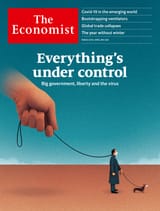Search Results
7/3/2025, 4:56:45 AM
>>509364242
But in spite of all the trouble governments have in reaching and (harder still) sticking to international agreements about macroeconomic policy, the conviction is growing that exchange rates cannot be left to themselves. Remember that the Louvre accord and its predecessor, the Plaza agreement of September 1985, were emergency measures to deal with a crisis of currency instability. Between 1983 and 1985 the dollar rose by 34% against the currencies of America's trading partners; since then it has fallen by 42%. Such changes have skewed the pattern of international comparative advantage more drastically in four years than underlying economic forces might do in a whole generation.
In the past few days the world's main central banks, fearing another dollar collapse, have again jointly intervened in the currency markets (see page 62). Market loving ministers such as Britain's Mr. Nigel Lawson have been converted to the cause of exchange-rate stability. Japanese officials take seriously the idea of EMS-like schemes for the main industrial economies. Regardless of the Louvre's embarrassing failure, the conviction remains that something must be done about exchange rates.
Something will be, almost certainly in the course of 1988. And not long after the next currency agreement is signed it will go the same way as the last one. It will collapse. Governments are far from ready to subordinate their domestic objectives to the goal of international stability. Several more big exchange-rate upsets, a few more stock market crashes and probably a slump or two will be needed before politicians are willing to face squarely up to that choice. Tis points to a muddled sequence of emergency followed by a patch-up followed by emergency, stretching out far beyond 2018 - except for two things. As time passes, the damage caused by currency instability is gradually going to mount; and the very tends that will make it mount are making the utopia of monetary union feasible.
But in spite of all the trouble governments have in reaching and (harder still) sticking to international agreements about macroeconomic policy, the conviction is growing that exchange rates cannot be left to themselves. Remember that the Louvre accord and its predecessor, the Plaza agreement of September 1985, were emergency measures to deal with a crisis of currency instability. Between 1983 and 1985 the dollar rose by 34% against the currencies of America's trading partners; since then it has fallen by 42%. Such changes have skewed the pattern of international comparative advantage more drastically in four years than underlying economic forces might do in a whole generation.
In the past few days the world's main central banks, fearing another dollar collapse, have again jointly intervened in the currency markets (see page 62). Market loving ministers such as Britain's Mr. Nigel Lawson have been converted to the cause of exchange-rate stability. Japanese officials take seriously the idea of EMS-like schemes for the main industrial economies. Regardless of the Louvre's embarrassing failure, the conviction remains that something must be done about exchange rates.
Something will be, almost certainly in the course of 1988. And not long after the next currency agreement is signed it will go the same way as the last one. It will collapse. Governments are far from ready to subordinate their domestic objectives to the goal of international stability. Several more big exchange-rate upsets, a few more stock market crashes and probably a slump or two will be needed before politicians are willing to face squarely up to that choice. Tis points to a muddled sequence of emergency followed by a patch-up followed by emergency, stretching out far beyond 2018 - except for two things. As time passes, the damage caused by currency instability is gradually going to mount; and the very tends that will make it mount are making the utopia of monetary union feasible.
Page 1
